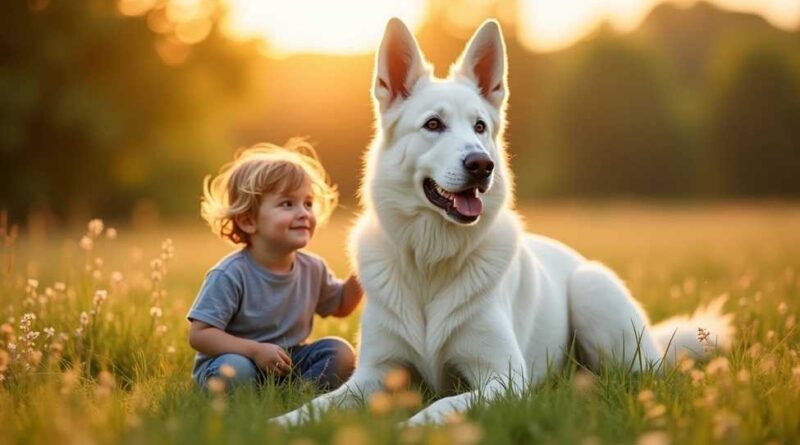White German Shepherd Temperament: The Truth Behind These Gentle Giants
White German Shepherd temperament may come as a surprise to you if you’ve only ever seen typical German Shepherds. Despite sharing the same breed genetics, these majestic white-coated dogs often display a notably calm demeanor that sets them apart from their colored counterparts.
In my experience working with these beautiful animals, I’ve found that white German Shepherds combine self-confidence with an eagerness to please, making them exceptional family companions. Importantly, the white shepherd temperament isn’t affected by their coat color, which simply results from a recessive gene. These gentle giants typically live between 10-14 years and are remarkably adaptable to different living situations. During my research, I’ve discovered that many people confuse the white German Shepherd with similar-looking breeds, but their distinctive personality traits—including their affection toward family members and natural protective instincts—make them uniquely suited as both companions and watchdogs. Throughout this article, we’ll explore what truly defines these impressive dogs and address common misconceptions about their behavior.
White German Shepherd vs Standard German Shepherd Temperament
Many people wonder if a white coat signifies different behavior patterns in these majestic dogs. Looking beyond appearances, I’ve discovered that color genes don’t influence personality or abilities.
Temperament similarities and differences
Genetically speaking, white German Shepherds possess identical temperament foundations as their standard-colored counterparts. According to breed authorities, “”. Even Max von Stephanitz, the breed’s founder, stated there is “no bad color of a German Shepherd Dog“. color does not affect the dog’s physical structure, personality, temperament or trainability
Both varieties share these fundamental traits:
- Loyalty and protectiveness toward family
- Intelligence and trainability with proper guidance
- Alertness and watchfulness in their surroundings
Nevertheless, some subtle differences emerge in practice. Many owners report that white German Shepherds often display a somewhat gentler disposition while maintaining their protective instincts. They frequently demonstrate exceptional affection with family members and typically maintain a calmer demeanor, making them excellent companions for quieter households.

White shepherd vs German shepherd temperament in work roles
Historically, standard German Shepherds gained popularity in police and military roles primarily because white coats created practical disadvantages in these settings. Dark-faced shepherds proved more effective at intimidating sheep during herding, while .white coats made working dogs too visible during tactical operations
Furthermore, white shepherds face discrimination in professional settings mostly due to appearance rather than ability. Their white shedding hair appears more noticeable on dark police and military uniforms. This esthetic concern, rather than temperament differences, has limited their adoption in certain working roles.
In reality, white German Shepherds possess identical working capabilities. They excel equally in Schutzhund (obedience, tracking, and protection training), can perform essentially all the same jobs, and hold the same titles on registration papers.
White Swiss shepherd vs German shepherd temperament
The White Swiss Shepherd (Berger Blanc Suisse) represents a separate breed with German Shepherd ancestry. While visually similar, significant temperament differences exist between these breeds.
AKC German Shepherd standards emphasize “fearless and direct” personalities ideal for police and guard work. Conversely, the White Swiss Shepherd standard calls for “mellower, more gentle” personalities that excel as therapy or service dogs.
Additionally, White Swiss Shepherds typically show more friendliness toward strangers compared to traditional German Shepherds. This key temperament distinction helps explain why White Swiss Shepherds often work as companion and therapy dogs rather than in traditional protection roles.
Ultimately, understanding these nuanced differences helps potential owners choose the right shepherd variety based on their lifestyle needs rather than simply coat color.
Debunking Myths: Are White German Shepherds Dangerous?
The fear surrounding white German Shepherds often comes from outdated beliefs that have persisted through generations of dog owners. Upon closer examination, these myths don’t stand up to scientific scrutiny.
Where the myth comes from
Historically, misconceptions about white German Shepherds began in the 1930s during Hitler’s reign in Nazi Germany. Unfortunately, white GSDs were during this period. This discriminatory stance continued after World War II when the German Shepherd Dog Club of America recognized only colored GSDs as the breed standard. Disqualified as “true” German Shepherds
The white coat was erroneously linked to health issues and genetic weaknesses. Some hardcore breed elitists still refuse to acknowledge scientific research, instead promoting misconceptions that originated nearly a century ago.
How temperament is misunderstood
Many first-time observers automatically assume a White German Shepherd suffers from a serious genetic issue. This misunderstanding extends to temperament, with some authorities incorrectly claiming these dogs may develop behavioral problems.
In truth, White German Shepherds typically exhibit a mellower, milder, and gentler temperament than standard GSDs. Their gentle demeanor resembles that of a Golden Retriever, yet they maintain the confident stance characteristic of German Shepherds.
Ironically, their calm disposition has sometimes been misinterpreted as shyness or reclusiveness, particularly when they haven’t been properly socialized.
What science and breeders say
Scientific research effectively debunks these persistent myths:
- White GSDs are not albinos – they have brown eyes, dark pigmentation, and black noses
- The white coat comes from a recessive allele of the E gene, not from albinism
- Known health issues affecting German Shepherds have nothing to do with coat color
- Genetic research proves White German Shepherds are not “faulty” and do not “dilute” the breed
Regardless their color, German Shepherds are roughly as, according to the American Temperament Test Society. Studies on canine behavior genetics show that aggression is influenced by multiple factors including genetics, socialization, and training – not coat color. Aggressive as Golden Retrievers
Experienced breeders confirm that with proper socialization, white German Shepherds become confident around strangers – reserved but polite and non-aggressive.
What Influences a White Shepherd’s Behavior?
Understanding what shapes a white German shepherd’s temperament requires looking at multiple factors. Unlike what some might believe, their behavior isn’t solely determined by their striking white coat.
Genetics vs environment
Every white shepherd inherits certain behavioral tendencies from their parents. These genetic foundations establish baseline temperament traits such as confidence, energy levels, and social tendencies. Although genetics create the framework, environment ultimately determines how these traits express themselves.
Think of genetics as providing the blueprint, while daily experiences construct the actual building. Most experienced breeders agree that puppies from stable, even-tempered parents typically display better baseline temperaments themselves. Yet, even the best genetic foundation can be undermined by poor handling.
Impact of training and socialization
A white German shepherd’s lifelong behavioral habits are greatly influenced by the crucial socialization stage, which lasts from 3 to 14 weeks. During this window, puppies learn crucial lessons about their world that shape their adult temperament.
Proper socialization includes:
- Exposure to different people, animals, sounds, and environments
- Positive experiences with various stimuli
- Building confidence through appropriate challenges
Without adequate socialization, white German shepherds may develop fearfulness or reactivity despite excellent genetics. For this reason, early positive experiences profoundly affect how these dogs respond to new situations throughout their lives.
Health issues that affect temperament
Physical discomfort frequently manifests as behavioral changes in white German shepherds. Hip dysplasia, a common condition in the breed, often causes irritability or reluctance to engage in activities when pain flares up. Similarly, thyroid imbalances can trigger sudden personality shifts, including unusual aggression or lethargy.
Other conditions affecting white shepherd temperament include:
- Sensory decline (hearing/vision loss) causing startle responses
- Gastrointestinal problems creating irritability
- Neurological issues manifesting as behavioral changes
Owners sometimes misinterpret health-related behavior changes as training failures or temperament flaws. For these amazing canines, regular veterinarian treatment is therefore essential to preserving their physical well-being and steady temperament.

Choosing the Right White Shepherd for Your Home
Finding your perfect white shepherd companion hinges on several important considerations that directly impact your long-term relationship with these remarkable dogs.
American white shepherd dog vs European lines
Compared to their European counterparts, American white shepherds tend to have more elegant heads and angled torsos. In terms of temperament, American lines often excel as family companions, showing elegance and graceful movement that makes them ideal show dogs.
European white shepherds, meanwhile, possess straighter hind legs, bigger heads, and a more working-oriented temperament. They frequently demonstrate stronger protective instincts that make them excellent candidates for guard duties. Importantly, European-bred shepherds undergo through organizations like the SV (German Shepherd Club of Germany), potentially resulting in more consistent temperaments. More rigorous breeding regulation
Male vs female temperament differences
Male white shepherds generally exhibit more territorial behavior toward property, whereas females tend to be more protective of people. This fundamental difference affects many aspects of their personality.
Males typically:
- Bond primarily with one main handler
- Appear more independent and willing to explore farther from home
- Require more consistent boundaries to prevent dominance issues
Females generally:
- Form connections with multiple family members
- Stay closer to their “pack” with less wandering tendencies
- Show more affection and sometimes exhibit “touchier-feelier” behavior
First-time owners should note that females occasionally display resource guarding or jealousy toward other animals and people.
Tips for first-time owners
Initially, prioritize proper socialization and consistent training from puppyhood. White German shepherds require alongside substantial mental stimulation. Approximately two hours of daily exercise
Subsequently, establish firm leadership while avoiding harsh methods—these intelligent dogs respond best to positive reinforcement techniques. Undoubtedly, providing plenty of family interaction is crucial as these dogs bond strongly with their people and struggle when left alone for extended periods.
Ultimately, white shepherds thrive with owners who understand their needs for structure, exercise, and companionship. Their loyalty and protection instincts make the investment of time and training tremendously rewarding.
Final Thought
Throughout my experience with these magnificent animals, I’ve discovered that White German Shepherds truly represent misunderstood gems in the canine world. Despite decades of misconceptions, these dogs consistently prove themselves as exceptional companions with intelligence, loyalty, and a uniquely gentle disposition. Their white coats, while striking, ultimately have no bearing on their remarkable abilities or temperament.
Science has certainly validated what responsible breeders and owners have known all along—White German Shepherds possess the same capabilities as their standard-colored relatives. Therefore, potential owners should focus less on coat color and more on finding a shepherd with temperament traits matching their lifestyle. After all, the real factors determining your experience will include proper socialization, consistent training, and understanding the differences between male and female specimens.
Ultimately, White German Shepherds thrive with owners who provide structure while honoring their need for exercise, mental stimulation, and family interaction. Their balanced mixture of protectiveness and affection makes them ideally suited for families seeking a loyal guardian with a gentle heart. These magnificent animals deserve appreciation based on their true nature rather than outdated myths or prejudices about their appearance.
White German Shepherds will reward your investment of time and care with unwavering devotion and companionship. Above all, these beautiful dogs represent everything wonderful about the shepherd breed—wrapped in an elegant white package that stands as testimony to nature’s remarkable diversity.
FAQs
Q1. Are White German Shepherds more aggressive than standard German Shepherds?
A1. No, White German Shepherds are not more aggressive. In fact, they often display a gentler disposition while maintaining their protective instincts. Their temperament is influenced by genetics, socialization, and training, not coat color.
Q2. Do White German Shepherds have the same abilities as regular German Shepherds?
A2. Yes, White German Shepherds possess identical working capabilities as their standard-colored counterparts. They can excel in various roles, including obedience, tracking, and protection training. Any limitations in professional settings are typically due to esthetic concerns rather than ability.
Q3. Do White German Shepherds require a lot of exercise?
A3. White German Shepherds require approximately two hours of daily exercise, along with substantial mental stimulation. They thrive with owners who can provide regular physical activity and engaging tasks to keep them mentally sharp.
Q4. Are there temperament differences between male and female White German Shepherds?
A4. Yes, there are some general differences. Males tend to be more territorial and independent, while females are often more protective of people and form connections with multiple family members. However, individual personalities can vary.
Q5. Are White German Shepherds good family pets?
A5. White German Shepherds can be great companions for the family. They are renowned for their affectionate nature, intellect, and loyalty. With proper socialization and training, they typically display a calm demeanor and strong bonds with family members, making them well-suited for various household dynamics.



